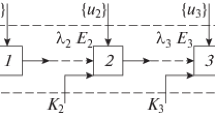Abstract
An organized approach is considered for determining the best functional (usually polynomial) form of a mathematical model for a complex system using the minimum ofa priori information. It is necessary to know only the list of the variables that may possibly take part in the model, the corresponding table of data, and the general criterion that the model is to satisfy (e.g., “the prediction is to be accurate” or “the model is to be unbiassed”). The computer, with the help of a special organized sifting of models, uses the self-organization principle to find a unique model of optimal complexity.
Similar content being viewed by others
References
A. G. Ivakhnenko, “Polynomial theory of complex systems,”IEEE Trans. Syst., Man, Cybern. SMC-1:364–376 (1971).
Yu. V. Koppa, “AnA 3 Go 3-Bésm 6 programme for interpolation using the GMDH algorithm with polynomials of first and second degree,”Sov. Autom. Control 4(1):69–71 (1971).
A. G. Ivakhnenko, Yu. V. Koppa, N. N. Todua, and G. Petracne, “Mathematical simulation of complex ecological systems,”Sov. Autom. Control 4:(1):15, 626 (1971).
A. G. Ivakhnenko, “Problems of simulation of complex systems and of applied mathematical statistics,”Sov. Autom. Control 4(6):1–6 (1971).
A. G. Ivakhnenko and Yu. V. Chukin, “Purposeful regularization in short and medium term prediction problems by finding the trend of optimum complexity,”Sov. Autom. Control 5(1):43–49;6:55–58 (1972).
D. Gabor, “Summary of ‘Perspective of Planning’, ”Sov. Autom. Control 5:58–67 (1972).
R. Shankar, “The Group Method of Data Handling,” MA thesis, University of Delaware, College Park, Md. (1972).
A. G. Ivakhnenko, “Structural identification of differential equations by small number of observations using self-organization methods,”Sov. Autom. Control 5:31–54;5(6):6–12 (1972).
A. G. Ivakhnenko, and N. N. Todua, “Prediction of random processes using self-organization at the prediction equations,”Sov. Autom. Control, Part 15(3):31–51; Part u6(2):32–47; Part III6(3): 11–28 (1972).
N. A. Ivakhnenko and M. Z. Kvasko, “Combination-generating GMDH algorithm in which the regularity of both ‘symmetrical’ and ‘nonsymetrical’ polynomials is checked,”Sov. Autom. Control 5(5):33–38 (1972).
A. G. Ivakhnenko, N. N. Todua, and A. A. Fomichev, “Structural synthesis of filters for indirect measurement of variables and the generalized GMDH algorithm,”Sov. Autom. Control 6(1):37–46 (1973).
A. G. Ivakhnenko and V. A. Toloknyanenko, “Control with prediction optimization: simple continuous plant model,”Sov. Autom. Control 6(2):48–55 (1973).
A. G. Ivakhnenko, G. Petrache, N. V. Gulyan, and V. A. Ovchinnikov, “Control of complex systems with prediction optimization based on self-organization,”Sov. Autom. Control 6(4):24–40 (1973).
A. G. Ivakhnenko, V. V. Shervashidze, O. I. Sheludko, S. G. Patereu, and N. A. Ivakhnenko, “Discovery of physical laws with the absence-of-bias criteria,”Sov. Autom. Control 6(6):32–44 (1973).
A. G. Ivakhnenko and N. A. Ivakhnenko, “Long term prediction of random processes by the GMDH algorithms with the unbiassedness and variable balance criteria,”Sov. Autom. Control 7(4):40–45 (1974);8(4):50–60 (1975).
J. I. Duffy, “Identification at Soil Nitrogen Transformations in Agricultural Ecosystem,” PhD thesis, Washington University, Sever Institute of Technology, St. Louis, Mo. (1974).
P. Parks and A. Ivakhnenko, “Self-organization of the Britain economic system model (by balance-of-variable criterion) for the prediction optimization control,”Sov. Autom. Control (6) (1974).
“The developing of GMDH in the USA,” Summary, Part II,Sov. Autom. Control 7(2):50–68 (1974).
H. S. Witsenhausen, “On the uncertainty of future preferences,”Ann. Econ. Soc. Meas. 3:91–94 (1974).
Y. Bar-Shalom and E. Tse, “Dual effect, certainty equivalence and separation in stochastic control,”IEEE Trans. Autom. Control, 494–500 (October 1974).
S. K. Kasperovich, “Modeling Complex Systems with Multipolynomial Networks,” IEEE Region Six Conference, US Western Region, Minicomputers and Their Applications, Honolulu, Hawaii, (May 2–4, 1973).
D. F. Scott and C. Hutchison, “Modelling of Economic Systems,” National Science Foundation, University of Massachusetts, Amherst (March 1975).
J. Duffy and M. A. Franklin, “Case Study of Environmental System Modeling with the Group Method of Data Handling,Proceedings of the 1973 JACC, Ohio State University, Columbus, Ohio (1973).
Author information
Authors and Affiliations
Rights and permissions
About this article
Cite this article
Ivakhnenko, A.G. Development of models of optimal complexity using self-organization theory. International Journal of Computer and Information Sciences 8, 111–127 (1979). https://doi.org/10.1007/BF00989666
Revised:
Issue Date:
DOI: https://doi.org/10.1007/BF00989666




